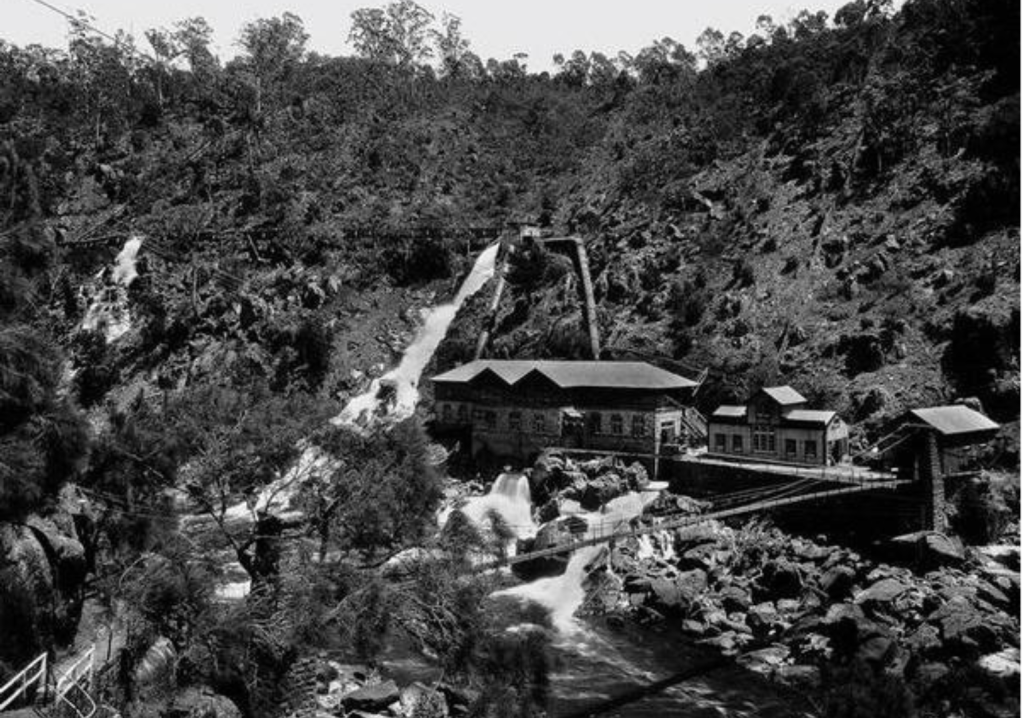An icon of Tasmanian engineering heritage, the Duck Reach Power Station was designed to harness the hydro-electric power generated by a nearby river.
The design and construction of the Duck Reach Power Station in the 1890s was a huge commitment for the Launceston City Council.
The initial aim was to harness the hydro-electric potential of the nearby South Esk River to light the streets of the city. The generators would produce both direct current (DC) power for arc lights and alternating current (AC) for incandescent lights and electric motors.
The scheme was located on a big bend in the river. Water was diverted into a tunnel across the bend and down the hillside in a penstock to the station on the riverbank below the bend.
Five small machines produced DC power, while three larger machines produced AC. The station output was 360 kW. Transmission lines conveyed the power to a substation in the city.
In response to the rapidly growing demand for electricity, more water was delivered via a second penstock from the tunnel in 1905, and a timber flume was built from the tunnel entrance all the way around the river bend to the tunnel outlet in 1921.
More and larger machines were progressively installed, raising the station output to 2000 kW by 1921. The Duck Reach scheme enabled the city to attract new industries.
The past
Tragedy struck in 1929 when the power station building was badly damaged by an enormous flood in the South Esk River. The flood caused serious flooding in the City of Launceston.
Fortunately, the former Tasmanian Hydro-Electric Department had built a transmission line from the Waddamana Power Station to Launceston in 1921, and this maintained the power supply to Launceston while the Duck Reach Power Station was being reconstructed.
In 1944, the Duck Reach station was taken over by the Tasmanian Hydro-Electric Commission (‘the Hydro’). Duck Reach continued to provide sterling service until 1955, when its water supply was diverted to the new Trevallyn Power Station. Duck Reach Power Station was then decommissioned.
Learn more about the Belconnen Naval Transmitter Station, an engineering heritage site which proved critical for communications during World War II.
Due to continued vandalism, the Hydro removed the machines and equipment from the Duck Reach station in 1956 and donated them to various institutions. The station building gradually fell into disrepair.
In 1988, funds were obtained to re-roof the building, improve access to the suspension bridge and reinstall one small machine as a static exhibit. The result was a large building with very little inside it.
The present
For some time, lobby groups in Launceston have been keen to improve the visitor experience at the station. A grant of funds enabled a 10-minute video to be prepared and displayed on an inside wall to tell the Duck Reach story when visitors enter, and the interpretation panels have been upgraded.
A lobby group led by Gus Green has persuaded the Hydro to release one small 12 kW Duck Reach machine from the Waddamana Museum, and that turbo-generator has been lifted into Duck Reach station by helicopter.
This machine is brightly painted and has some of its casings cut away so that the inside workings can be seen.

The lobby group has long held the aim to get an original 445 hp turbine and 300 kW alternator out of the bulk storage shed of the Queen Victoria Museum in Launceston and reinstall them in the Power Station building.
The machines have been transported to a workshop in Launceston, complete with the large concrete blocks on which they were founded when they were on display near Trevallyn Dam. The blocks have been removed, and the machines have been carefully dismantled into lighter components, cleaned up and painted.
A significant problem for the reinstallation is the lack of road access to the site. To convey the parts across the river to the station, the plan is to build a five-tonne cableway, and work on this has begun.
In the station, there is an existing walkway through the length of the building which will have to be modified to make room for the machines. The intention is to place the machines on their original holding down bolts, which still exist in the station.
The inlet pipe between the station wall to the gate valve on top of the turbine is missing and will have to be measured up and fabricated.
The future
There is a proposal by a private company, by agreement with the Hydro, to install a mini hydro generator in the station using water released from Trevallyn Dam. This will involve delivering the water to the station via a smaller pipe from the tunnel outlet down the hillside inside an existing penstock.
The power produced will be sold to the Hydro.
If this occurs, it is also proposed to divert a small amount of water to the reinstalled 1905 machine to enable it to generate enough power to light the station. There will be technical problems to be overcome, so we live in hope at this stage. If the plans are successful, we would then have a live exhibit instead of a static one.
A version of this article originally appeared in the March 2023 edition of the Engineering Heritage Australia magazine.
Bruce Cole FIEAust CPEng is Chair of Engineers Australia (Tasmania) Heritage Committee.
